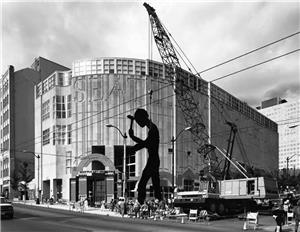On Labor Day, September 6, 1993, art-warfare guerrillas attach a 700-pound ball and chain to Hammering Man, the 48-foot-tall metal sculpture by Jonathan Borofsky that stands in front of the Seattle Art Museum in downtown Seattle. The prank is a statement about the oppression of working people.
A 12-member group led by Subculture Joe, later identified as Jason Sprinkle (1969-2005), fabricated a six-foot sheet-metal ball, 19 feet in circumference. It was attached to nine links of chain made of plate steel and a five-foot shackle. The shackle was lined with industrial rubber to prevent damage to the sculpture. On Wednesday September 8, two days after the ball and chain was attached to the sculpture, the Seattle Engineering Department removed it.
On October 22, 1993, the ball and chain was auctioned by Allied Arts at the request of the Seattle Arts Commission at the Stouffer Madison Hotel as part of a fundraiser for the Job Corps. In order to fit through the ballroom doors, it had to be deformed by ramming it with a truck. The slightly dented guerrilla art was purchased for $1,300 by two collectors from Tacoma, who planned to display it in a building there.
During the week of the auction, vandals painted socks on Hammering Man and spray-painted "Made in USA" on the wall of the Seattle Art Museum.
Subculture Joe (or Jason Sprinkle) was in the news a few years later when he parked a pickup truck containing a heart-shaped, red metal sculpture in Seattle's Westlake Park at 4th Avenue and Pine Street. Words painted on the truck led some to believe, erroneously, that the truck contained a bomb, and police evacuated a nine-block area. Sprinkle was later arrested.
On May 16, 2005, Jason Sprinkle was killed when he was hit by a freight train in Long Beach, Mississippi, where he was visiting his aunt and looking for work. There were no witnesses and it is unclear how this happened.

